By Gene Eric Salecker
By the time the attack on Pearl Harbor plunged the United States into World War II, Japan had been preparing for an all-out offensive in the Pacific for months.
Japan relied on imports of raw materials and natural resources to survive. Rubber, tin, iron, and especially oil had to be imported for Japanese industry to function. The same raw materials were also essential for the Japanese war machine.
In 1894-1895, Japan defeated China in a short war and gained control of the island of Formosa, part of Korea, and a bit of Manchuria. Along with these territories came all their natural resources. In 1905, after Japan defeated Russia in the Russo-Japanese War, the Empire of the Sun took control of all of Korea and part of Manchuria that had earlier been gobbled up by the Russians.
On September 19, 1931, in the midst of a worldwide depression, Japan staged an incident at a railway station on the Korean border of Manchuria, which it used as an excuse to invade the mineral-rich Chinese province. When the League of Nations condemned the act, Japan resigned from the League. In 1936, to expand her navy, Japan renounced the 1922 Washington Naval Treaty, which had limited the size of the Japanese Navy. In July 1937, Japan launched a full-scale invasion of China on the pretext that Chinese soldiers had fired on Japanese troops in Manchuria. Although Japan could not conquer all of China, by 1939 it had captured almost all of the important port cities and had firm control of the raw material that went into or out of the Asian giant.
In June 1940, after Japan moved into French Indochina while France was under Nazi occupation, the U.S. Congress passed the Export Control Act, which prohibited the export of “strategic minerals and chemicals, aircraft engines, parts, and equipment” to Japan. Conspicuously absent from this list was crude oil.
The already strained relations between the United States and Japan worsened in September 1940 when the Japanese signed the Tripartite Pact with Nazi Germany and Fascist Italy. Hitler, who was already planning to start a war in Europe, was hoping that the Tripartite Pact would encourage Japan to invade the British holdings in the Far East to pin down forces already there.
At the same time, the Japanese hoped that the pact would provide security as they formulated plans to invade and capture the rich oilfields of the Netherlands East Indies. In response to the Tripartite Pact, the United States embargoed even more material—brass, copper, and iron. Still, President Franklin D. Roosevelt stopped short of barring Japanese purchases of oil.
By the spring of 1941, Japan signed a five-year nonaggression pact with Russia, assuring that her backdoor was closed and safe. Next, Japan moved more troops into French Indochina and began eyeing the Netherlands East Indies. In response to the troop movements, Roosevelt froze all Japanese assets in the United States and after much consideration finally placed an embargo on crude oil.
On the heels of the American embargo, the Dutch proclaimed that the Netherlands East Indies would also stop selling oil to Japan. To conquer the Netherlands East Indies and capture its vital oilfields, Japan first had to eliminate the British stronghold of Singapore, crush the American forces in the Philippines, and cripple the U.S. Pacific Fleet at Pearl Harbor. Within 24 hours on December 7, 1941, Japan launched attacks against Pearl Harbor, the Philippines, Singapore, Hong Kong, Northern Malaya, Thailand, Guam, Wake Island, and Midway Atoll and began planning to capture the island of Sumatra, east of Java, along with the oil refineries and a key airfield in the vicinity.
In December 1940, the Japanese Army began experimenting with airborne forces. Training of the first volunteers took place at Ichigaya near Tokyo. Requirements for the unit were rigid. Most of the volunteers were between the ages of 20 and 25, and officers could be no older than 28. All had to go through a rigid medical examination. Additional psychological and physical tests were administered and, acting on the belief that paratroopers had to have cat-like abilities to land safely, volunteers were given intense physical fitness training similar to that of a gymnast.
After about 250 volunteers were selected, training moved to a Tokyo amusement park that had a special ride featuring a 165-foot parachute drop. Historians Gordan Rottman and Akira Takizawa wrote, “Thrill seekers were attached to a canopy that was hoisted by cable before being released to float to the ground. Because the existence of the paratroop unit was secret, trainees were directed to visit the park disguised as university students, to experience a couple of simulated descents.” Additional training consisted of somersaults and tumbling, leaping from various heights to learn landing techniques and, finally, actual jumps from moving planes.
Once the original group of volunteers was sufficiently trained, it was broken into cadres to absorb new trainees. By January 1942, the Army had enough paratroopers trained to form the 1st Raiding Brigade under Colonel Seiichi Kume consisting of the 1st Raiding Brigade Headquarters, the 1st Raiding Regiment (Major Takeo Takeda), and the 2nd Raiding Regiment (Major Takeo Komura). Additionally, the 1st Raiding Flying Regiment (Major Akihito Niihara), an air transport group, was attached to the brigade so that the paratroopers would have their own autonomous airplane group. Each regiment consisted of only about 700 men, rather than the 3,800 of a standard infantry regiment. Each regiment included a regimental headquarters group, three rifle companies, and an engineer company.
Preparations for the Army parachute drop on Sumatra had actually been completed by late December 1941, but an accidental fire aboard the cargo ship Meiko Maru on January 3, 1942, which was transporting the 1st Raiding Regiment to an airfield on the Malay Peninsula, caused the paratroopers to abandon ship without their parachutes, equipment, and weapons. Exhausted and battered from their harrowing ordeal and stranded on Hainan Island off the northern coast of French Indochina, the paratroopers were in no shape to stage a combat parachute drop.
When word of the disaster reached the Imperial Army General Staff, they turned to Major Komura and his 2nd Raiding Regiment. Although the unit was still being organized, approximately 450 paratroopers drew weapons, equipment, and parachutes. On January 15, the understrength 2nd Raiding Regiment left Kyushu, arriving at Phnom Penh, Cambodia, on February 2.
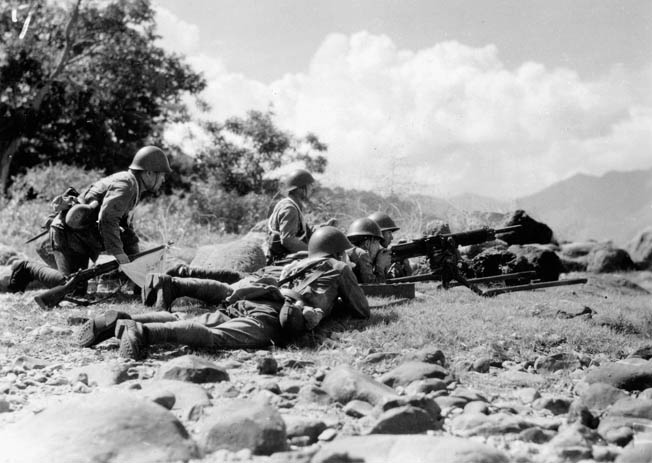
The 2nd Raiding Regiment was broken into the 1st and 2nd Attack Groups for the air assaults on the Palembang airfield and oil refineries. The 1st Attack Group, consisting of about 350 officers and men, would be transported to the area in the 1st Raiding Flying Regiment’s Tachikawa Type LO “Thelma” and Mitsubishi Ki-57 Type 100 Model 1 “Topsy” aircraft, with a scheduled drop on February 14. One day later, the 2nd Attack Group, containing only 90 officers and men, would be dropped by the 12th Transport Chutai. Inexplicably, the small cargo containers carrying the rifles, machine guns, ammunition, and other supplies would be dropped by the 98th Sentai from 27 twin-engine Mitsubishi Type 97 “Sally” medium bombers. This plan worried the paratroopers. “If the [containers] were misdropped or delayed,” wrote historians Rottman and Takizawa, “the paratroopers on the ground would be forced to fight a well-armed enemy with only pistols and grenades.”
Both flights were to be escorted by Nakajima Ki-43 “Oscar” fighter planes from the 59th and 64th Sentai. Additionally, the initial drop would be preceded by nine Kawasaki Ki-48 Type 99 “Lily” light bombers from the 90th Sentai dropping antipersonnel bombs across the Dutch airfield.
By February 13, the entire attack force had moved from Cambodia to the west side of the Malay Peninsula, with the 1st Attack Group assembling at the recently captured Allied airfields at Keluang and Kahang and the 2nd Attack Group moving to Sungai Petani. Toasting each other with saké, the officers and men prepared for their early morning drop at Palembang, the capital of Sumatra.
Palembang, with a population of more than 108,000, was situated on the Moesi River about 50 miles inland from the Banka Strait. It was said that its oilfields were the best in Southeast Asia. Two oil refineries had been constructed about four miles east of the town on the south side of the Moesi River. A tributary of the Moesi, the Komering River, divided the two refineries. On the east bank and farthest away from Palembang was the Nederlandsche Koloniale Petroleum Maatschappij (NKPM), a refinery for the Standard Oil Company. On the west bank was the Bataafsce Petroleum Maatschappij (BPM), owned by Shell Oil. The latter refinery was built as two separate installations, one opposite the NKPM refinery on the west side of the Komering River and the other a short distance away on the south bank of the Moesi River.
Even though the Dutch could predict that the Japanese would want the two refineries intact, they did not intend to destroy the facilities prematurely. In addition to a well-known civilian airfield called Pangkalanbenteng (P1), eight miles north of Palembang, there was a recently constructed military airfield, Praboemoelih (P2), 40 miles to the south. P1 had been used by civilian aircraft for years and had a hard concrete runway, barracks buildings, and control tower. Unfortunately for the Dutch, P1 was well known to the Japanese. However, the newly established P2 had a cleverly concealed dirt runway with room beneath the surrounding jungle canopy to hide Allied airplanes. Because of its well-hidden location, P2 was unknown to the Japanese.
The British Royal Air Force (RAF) had chosen Palembang as its headquarters on Sumatra. By the middle of January as the Japanese pushed closer, the RAF based a half dozen fighter and bomber squadrons at P1 and P2. Using the high-octane aviation fuel produced at the two refineries, the British pilots flew dozens of sorties against the rapidly advancing Japanese in the region.
The entire area around Palembang was under the command of Lt. Col. L.N.W. Vogelesang of the Royal Netherlands East Indies Army (KNIL) Territorial Command Dutch Sumatra. P1 was garrisoned by the South Sumatra Garrison Battalion, about 110 men, and two old armored cars. Since Japanese aircraft were shooting up more planes on the ground than personnel, there were more airmen than aircraft at P1. Subsequently, three officers and 72 grounded airmen of the RAF and Royal Australian Air Force (RAAF) were formed into a makeshift ground defense unit. Unfortunately, these men lacked the proper weapons and adequate training as riflemen.
In the town of Palembang, Colonel Vogelesang had one Stadswacht/Landstorm (home guard/reserve) infantry company and eight stationary 75mm field guns. A machine-gun company of KNIL regulars was stationed at the oil refineries. Vogelesang lacked any antiaircraft guns to protect the airfields and refineries until two batteries of the 6th Heavy AA Regiment, Royal Artillery, and one battery of the 35th Light AA Regiment, Royal Artillery, with 16 heavy 3.7-inch AA guns and 16 40mm Bofors AA guns respectively arrived from Singapore on February 2. One troop of the heavy antiaircraft battery, about 150 men, with six 3.7-inch and six Bofors guns, was sent to P1. A battery from the 6th Regiment and the light antiaircraft battery were sent to P2 with six 3.7-inch and six Bofors guns. One last troop, with the remaining four 3.7-inch and four Bofors guns, was sent to protect the refineries. Unfortunately, the ship carrying most of the ammunition for the antiaircraft guns was sunk, limiting the ability of the two regiments to engage the enemy.
To help defend the Palembang riverfront and the refinery docks, Colonel Vogelesang had one Royal Netherlands Navy minelayer, the HNLMS Pro Patria, and two patrol boats, the P-38 and P-40. All three vessels constantly patrolled the Moesi River with orders to contest any attempt by the Japanese to move up the river to Palembang. With everything in preparation, all the Dutch, British, and native defenders could do was sit and wait.
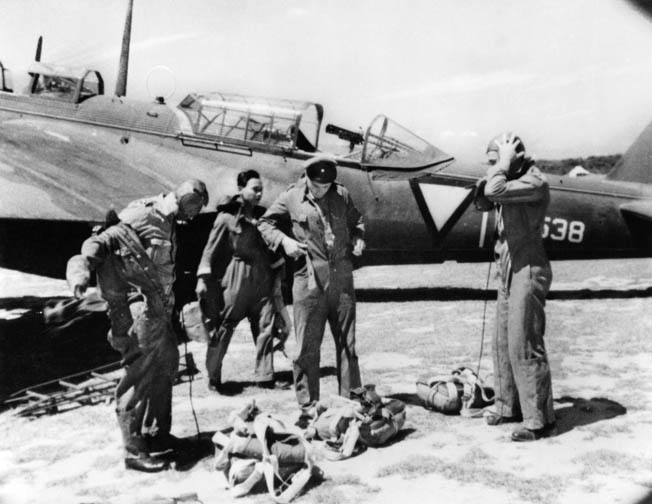
The overall Japanese plan was for the 2nd Raiding Regiment to capture the only known airfield, P1, and the two refineries. The Japanese wanted to seize the refineries intact and prevent the destruction of the facilities. Accordingly, the 2nd Raiding Regiment Headquarters group (17 men under Major Komura), Signal Unit (30 men led by Lieutenant Komaki), 4th Rifle Company (97 men under Lieutenant Mitsuya), and the 3rd Platoon, 2nd Rifle Company (36 men commanded by Lieutenant Mizuno), a total of 180 men, would land three-quarters of a mile southeast of the airfield. Another group, the 1st and 2nd Platoons, 2nd Rifle Company (60 men with Lieutenant Nobutaka Hirose in charge) would land one-eighth of a mile west of P1. Once on the ground, the two units (240 men) would move forward, envelop, and seize the airfield.
At the same time, the 1st and 2nd Platoons from the 1st Rifle Company (60 men led by Lieutenant Kikuo Nakao) were to be dropped one-third of a mile west of the Shell Oil BPM facilities on the west side of the Komering River. Simultaneously, the 3rd Platoon, 1st Rifle Company (39 men under Lieutenant Hasebe) would land almost a half mile south of the Standard Oil NKPM facility on the east side of the Komering. After the entire 1st Attack Group was on the ground, Colonel Kume and some of his staff would crash-land a transport between the airfield and Palembang. Inside would be a 37mm antitank gun. Once everyone was on the ground, the paratroopers were to dash forward, seize the airfield and both oil facilities, and hang on until relieved by reinforcing units landing by sea and advancing up the Moesi River.
Reinforcements for the understrength parachute regiment would come with an amphibious landing by the 229th Infantry Regiment and one battalion from the 230th Infantry Regiment, both from the 38th Infantry Division. As planned, the infantrymen would land at the mouth of the Moesi River on barges and charge upriver to Palembang. Until they arrived, which was expected to take two days, the paratroopers’ only immediate reinforcements would come from the 2nd Attack Force —90 men under Lieutenant Ryo Morisawa from the 3rd Company. These few men were scheduled to be parachuted onto P1 on the second day. Even then, the 2nd Raiding Regiment would be hard pressed to hold its assigned objectives until the infantry arrived.
On February 10, a British reconnaissance plane spotted the invasion convoy north of Banka Island and guessed correctly that it was headed toward Palembang. Throughout the next few days and nights, the British repeatedly attacked the Japanese ships, and by February 14, the Dutch, British, and native Sumatrans around Palembang were well aware of the intention of the Japanese. At first light, 15 Hawker Hurricane fighters, the only serviceable planes at P1, took off to escort a couple of flights of RAF bombers from P2 for attacks against the fast-approaching Japanese convoy.
The transports containing the 2nd Raiding Regiment paratroopers began taking off from the Malay airfields around 8:30 am. In all, 150 planes were on their way for the air assault on Sumatra.
While the flight was still 100 miles from Palembang, the Japanese were spotted by an Allied observation post, and word was immediately relayed to P1. Air Commander S.F. Vincent, in charge of one of the RAF squadrons at P1, immediately “arranged for the airfield defense officer to be warned to expect a paratroop assault, ordering that rifles and ammunition be issued forthwith.”
Unfortunately for the RAF personnel, there were not enough rifles to pass around. Only about 60 airmen actually received weapons and positioned themselves to help the 200 KNIL regulars defend the airfield.
At 11:20 am, almost three hours after takeoff, the Japanese planes had reached the mouth of the Moesi River. Following the river and flying almost due south, the planes flew quietly past some outbound British bombers, never veering from their intended destinations. As the Japanese planes drew closer to both objectives, the British antiaircraft batteries at both the airfield and the oil refineries opened fire. A shell exploded in the breach of one of the Bofors antiaircraft guns, killing one man outright and wounding several others.
After the 90th Sentai bombers carpeted the airfield and barracks buildings, the Japanese fighters began strafing the area. While the fighters and bombers were engaged directly over the airfield, 18 transports flew in at about 600 feet at 11:26 am and began dropping Major Komura’s 180 paratroopers southeast of the airfield. At almost the same time, six more transports began dropping the 60 men from the 1st and 2nd Platoons of the 2nd Rifle Company west of the airfield.
A flight of 15 Hurricanes and a handful of Lockheed Hudson bombers that had just attacked the Japanese invasion convoy in the north suddenly arrived over the airfield. Coming in at high altitude through dense clouds, the British pilots spotted the enemy below them. While the bombers continued toward P2, the fighters, although low on fuel, immediately dove to the attack.
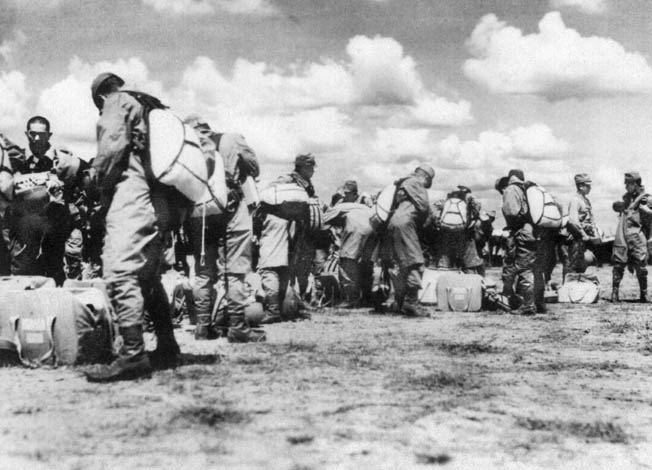
Coming out of the clouds, Pilot Officer Bill Lockwood and his wingman aimed for the leading Sally. Swooping in fast, Lockwood shot up the bomber, which was carrying some of the cargo containers. Pulling up sharply, Lockwood and his wingman leveled out and ran smack into a torrential rainstorm. By the time they got out of it, they were well past the airfield and had to follow the Moesi River back to Palembang. Nearing P1 a second time, Lockwood spotted a number of “white objects” on the ground and reasoned that Japanese paratroopers were in the midst of an attack. When he saw a red Very flare fired from P1 warning him not to land, Lockwood and his wingman flew on to P2.
The group of paratroopers landing southeast of the airfield was dropped about two miles away from P1 into an area covered with small trees. Supplies were scattered, and with some men armed only with the pistol and hand grenades they carried during the drop, the disorganized paratroopers began moving in small isolated groups toward the airfield.
One planeload of paratroopers, members of the 4th Rifle Company led by Lieutenant Minoru Okumoto, was supposed to land at the southeast drop zone but had a jammed door and did not get out of their plane in time. Instead, the paratroopers came down more than four miles south of the drop zone, near the main road that led from Palembang to the airfield. Moving quickly, Okumoto gathered four other men, all that he could find, and armed only with pistols and grenades began making his way north along the road to P1. During their movement, they cut the telephone lines between the airfield and town.
Meanwhile, west of the airfield the 60 men of the 1st and 2nd Platoons, 2nd Rifle Company under Lieutenant Hirose came down in dense, six-foot high reeds, although aerial photographs had indicated the area to be flat and covered with low grasses. Unable to find their cargo containers, small groups of paratroopers began making their way east toward the airfield, again armed only with pistols and hand grenades. Although Lieutenant Hirose could locate only two other men, he pushed on toward P1.
When the Japanese planes finally flew away, the Dutch and British defenders dug in, refusing to yield even an inch to the attacking Japanese. Ground and air crew personnel that had not gotten rifles removed Browning machine guns from unserviceable planes and set them up on mounds of earth. At the same time, the 3.7-inch and Bofors antiaircraft crews leveled their weapons and began to fire horizontally over open sights.
For the next hour or so, the defenders fought the first few Japanese that managed to reach the airfield. Widely scattered by the drop, many of the paratroopers arrived in ones or twos or in small groups. Some, after apparently retrieving their rifles from the scattered cargo containers, climbed into trees on the south side of the airfield and began sniping at the antiaircraft gun crews.
After the snipers had been dispersed, things became eerily quiet at the airfield. Most of the paratroopers had landed a few miles away from the field and were having a hard time gathering their things, coming together, and making their way toward P1. Taking advantage of the calm before the expected storm and realizing that the jig was up, a group of Dutch officers, who had been unable to reach headquarters at Palembang because of the cut telephone wires, decided to throw in the towel and began pulling the 200 widely spaced defenders out of P1.
While some of the men prepared to set fire to a stack of 44-gallon drums of aviation fuel and others were making preparations to destroy the unserviceable planes, the British artillerymen began the removal of their antiaircraft guns. Unfortunately, only one prime mover vehicle was available so only two guns could be moved. After sabotaging the other guns, most of the crews started down the road to Palembang while two crews began the process of moving the remaining two 3.7-inch antiaircraft guns.
Although a few carloads of retiring officers and men managed to escape from P1 via the main road leading south to Palembang, it was not long before the other vehicles were being fired upon by Lieutenant Okumoto and his small group of men who had been dropped far south of the airfield because of the jammed door. With his numbers now up to about 20 men, Okumoto laid in ambush around a curve in the road about four miles south of the airfield and waited. In no time a six-wheel truck came along and was immediately attacked with hand grenades and pistol fire, which succeeded in overturning the vehicle and creating a roadblock.
The next vehicle to come down the road was driven by Johnny Johnson, RAF. As he drove around the corner and spotted the overturned truck, he was attacked by Okumoto’s men. Although Johnson managed to get out of his vehicle and return fire with a revolver from a roadside ditch—reportedly hitting at least two paratroopers—he eventually ran out of ammunition and had to surrender. The Japanese commander then relieved Johnson of his revolver and shot him in the thigh, presumably to prevent his escape. Then, when it looked as though the other paratroopers were going to kill him, another vehicle was heard approaching from the direction of P1.
After scattering into the roadside ditches, the Japanese, with Johnson in tow, opened fire when the vehicle came into view. Full of RAF personnel, the car was hit by pistol fire and rocked by hand grenades, and it too flipped over, adding to the impromptu roadblock. A few of the RAF men were killed, but at least four were injured and captured. All four were quickly shot and killed by the Japanese paratroopers.
By the time the next few vehicles reached the roadblock, the evacuation from P1 was well underway. Although one vehicle managed to get safely through the growing roadblock, the others, including a fuel truck, did not. Hit with hand grenades, the fuel truck skidded out of control and flipped onto its side. Although the truck did not explode, one man was trapped underneath and the large vehicle added another obstacle in the middle of the road. Men from the other vehicles leaped out of the trucks and sought shelter in the jungle or in the ditches alongside the road. Those few evacuees with guns began firing back at the Japanese.
Meanwhile, the Dutch soldiers in Palembang were trying to organize reinforcements for P1. After gathering three truckloads of Dutch troops and an RAF van filled with food, Air Commander S.F. Vincent and his driver jumped into their own vehicle and led the convoy north toward P1. After going about nine miles they came around the bend in the road and ran smack into the enemy roadblock. Immediately, they came under fire. Although the van with the food supplies ended up in a ditch, the other trucks hurriedly turned around and fled back to Palembang without firing a shot. Wrote Commander Vincent, “I was disgusted and ashamed.”
Near noon, another attempt was made to reinforce the airfield when two armored cars and four troop trucks carrying about 150 Dutch soldiers approached the impromptu roadblock from Palembang. By this time, more Japanese paratroopers had come out of the jungle to reinforce Lieutenant Okumoto. When the Dutch convoy drew near the overturned fuel truck, the Japanese attacked with a fusillade of grenades, pistol fire, and fire from captured rifles. Taken completely by surprise, most of the KNIL soldiers abandoned their vehicles and fled back toward town, except for one of the armored car crews and one truckload of soldiers. In the ensuing firefight, two Japanese paratroopers were killed and Lieutenant Okumoto was wounded. Still, the Japanese somehow managed to hold the roadblock, force the remaining Dutch to flee, and capture the armored car.
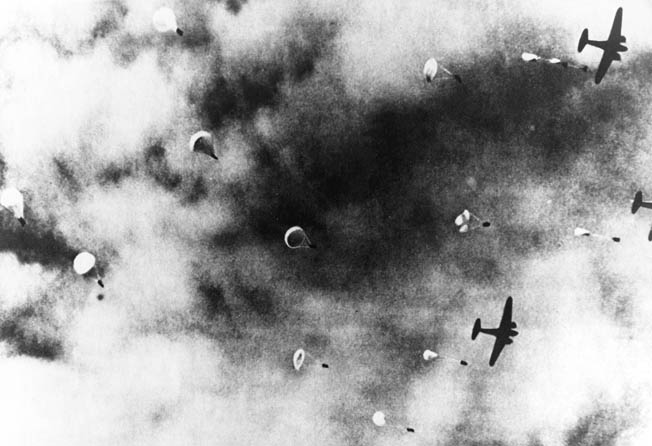
Shortly after 1:30 pm, Major Komura, who had been dropped to the southeast, arrived at the roadblock with about 25 men of the 4th Rifle Company. Komura decided that the roadblock should be maintained to stop any reinforcements from coming north from Palembang or catch any evacuees fleeing south from P1. Utilizing the captured armored car, Komura sent Lieutenant Ooki and 20 men north along the road toward P1 to capture the Dutch airfield office, situated about a mile south of the airdrome, while he positioned the rest of his men to defend the roadblock.
As planned, Colonel Kume’s transport, carrying his staff and a 37mm antitank gun and crew, had crash-landed several miles southeast of P1 shortly after the other paratroopers had landed. Unfortunately, the plane came down in a soggy woodland. Bogged down, wet, bitten by mosquitoes, and separated from most of his men, Kume would spend a sleepless night trying to get out of the quagmire.
After advancing only about three miles toward P1, Lieutenant Ooki and his armored car group ran into 300 Dutch soldiers and British airmen fleeing from the airfield. The evacuation of P1 was now completely underway. Opening fire with the captured armored car and side arms, the Japanese paratroopers surprised the fleeing men and began to push them back. At about the same time, groups of other paratroopers, some from the southeastern group and some from the western group, finally made it to the airfield and joined the attack.
On the west side, Lieutenant Gamo from the 2nd Rifle Company had managed to gather 16 men and push eastward toward the airdrome. Although the men were armed only with pistols and grenades, they did not hesitate to attack when they finally reached the edge of the airfield. Spotting a British antiaircraft position, Lieutenant Gamo threw a grenade and dashed forward. He was killed almost instantly. The other paratroopers, undaunted, continued to press the attack, although somewhat more cautiously than their leader.
The commander of the 2nd Rifle Company, Lieutenant Hirose, along with the only two men he could find, finally reached the airfield around 2 pm. Moving cautiously, Hirose and his men were slowly advancing toward a Dutch barracks when they suddenly spotted about 300 Dutch troops, perhaps the same men that were being attacked by Lieutenant Ooki and his armored car group. Overwhelmingly outnumbered, Hirose wisely pulled his two men back and slipped quietly into the surrounding jungle.
Back at the roadblock, things had begun to heat up again. Dutch troops and armed RAF personnel from Palembang had driven up close to the roadblock before parking their trucks to engage the enemy on foot. Creeping up through the jungle until they could see the Japanese, the Allied troops began sniping at Major Komura’s and Lieutenant Okumoto’s men. At the same time, a small group started to work their way closer, intent on setting the overturned fuel truck on fire. As the men neared the truck, they were informed by a few wounded Allied soldiers that a surviving RAF man was still trapped under the vehicle. While they discussed what to do, Japanese mortar rounds began to fall around them and enemy machine-gun fire began to tear up the trees. Making a hasty decision, the group abandoned their plan and fled into a nearby swamp.
Eventually, the Dutch and RAF riflemen got the upper hand at the roadblock and managed to chase Major Komura and the others away. Unfortunately, they were too late for the RAF trooper who had been trapped under the fuel truck. By the time the rescue group reached him, he had long since expired.
By now it was after 6 pm, and Lieutenant Ooki’s 20 paratroopers and captured armored car had managed to chase away the 300 Dutch and RAF defenders and capture the airfield office. Leaving a few men behind to guard the office, Ooki sent the armored car back toward the roadblock to inform Major Komura of his success while he took the rest of his men north toward the airfield.
At the roadblock, Flying Officer Macnamara, who had successfully fled from P1, and the others were milling about when the captured armored car suddenly appeared. “We naturally thought that the Dutch had at last broken through to our relief,” Macnamara recalled, “but after many had revealed themselves from the side of the road they were greeted with hand grenades.” Instantly realizing that the car was in Japanese hands, the Allied riflemen opened fire, causing the driver to crash into the other vehicles of the roadblock. “The Japanese,” Macnamara continued, “knowing their game was up … tried to make a break—a volley of fire from small arms—rifles and revolvers—greeted their exit from the turret.”
Perhaps realizing that the airfield might be under Japanese control, a small group of armed British airmen headed toward P1 and soon came upon the captured airfield office and the four or five Japanese paratroopers who had been left behind to guard it. A prolonged firefight then took place until about 20 Dutch reinforcements, one armed with a Bren gun, arrived and helped to overrun the hotly contested strongpoint.
In the meantime, at the airfield the paratroopers continued to arrive from their scattered drop zones and engage the defenders. By late afternoon most of the Allied defenders had either abandoned the airfield or been killed. Only about 60 armed RAF men and a few Dutch soldiers remained. Although they were running out of ammunition, they hung on stubbornly. RAF ground crewman Leslie Baker recalled, “[The] RAF ground crew were ready for them and the RAF lads stuck to their posts mowing down the Japs as they landed. We did, the RAF ALONE. [We] mopped up the Jap parachutists but not before we had had quite a few killed…. [It] made a mess of our aerodrome….”
The prime mover vehicle that had been attempting to pull two 3.7-inch antiaircraft guns to safety reached the main road leading to Palembang before it came under Japanese fire. “Unfortunately,” wrote a U.S. Army historian, “one of these [guns] had to be abandoned on the way, since light machine-gun fire had riddled the tires.” In fact, none of the antiaircraft guns made it out of P1. All 12 guns, most of them disabled by their crews, were captured by the paratroopers.
During a slight lull in the fighting, Wing Commander H.J. Maguire and Platoon Officer O.D. Creegan thought they heard troops on the road to Palembang and, imagining them to be Dutch reinforcements, hurried down the road to greet them. Instead, they met 60 to 70 Japanese soldiers assembling in the roadway. Knowing that they could not overwhelm the enemy by themselves, Maguire and Creegan decided to bluff their way out.
The two officers put down their guns and then walked up to the nearest Japanese soldier. “He looked very surprised but did nothing,” Maguire recalled. “So, sounding as confident as I could, I demanded to see his officer and, to my amazement, he shambled off and produced an officer. This officer had some command of English, and I immediately demanded surrender, saying that I had a large force behind me. He replied that he had a large force and that he would give us safe conduct if we marched out.” Continuing with their bluff, Maguire and Creegan said that they would have to discuss a possible surrender of the Allied command with their “non-existent senior officer” and then, turning around, walked back to their guns, picked them up, and walked calmly back to the airfield.
When the two officers arrived at P1, they discovered that the remaining handful of men had taken advantage of the lull in the fighting to set the fuel dump on fire and burn the remains of a few unserviceable aircraft. Then, using what few trucks remained, the 60 or so stalwart defenders had beaten a hasty retreat to the north, taking the road to Djambi. Maguire and Creegan quickly followed.
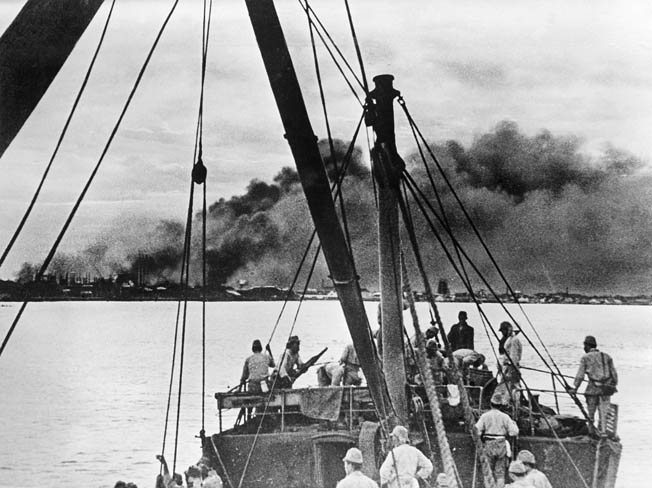
By 5 pm, P1 was completely devoid of Allied personnel. When Lieutenant Hirose and his three men finally came out of hiding on the west side of the airfield and approached the same barracks that they had approached before, they found it completely deserted. Looking around, they found cooked rations still on the stove, a fortunate happenstance since they had been unable to locate their drop containers and had only rice wafers and dried compressed fish with them.
An hour later, Major Komura, who had been gathering small groups of paratroopers into larger groups throughout the day, finally arrived at the airfield. Everything was quiet. The Allies had all fled or been killed. By the time darkness fell, P1 was in the hands of perhaps 100 army paratroopers of the 2nd Raiding Regiment.
At 11:30 am on February 14, 1942, six minutes after the paratroopers began dropping on P1, six Thelma transports began dropping Lieutenant Nakao and his 60 men from the 1st and 2nd Platoons, 1st Rifle Company on the west side of the Komering River close to the Shell Oil BPM facilities. At about the same time, the three Thelmas carrying Lieutenant Hasebe and his 39 paratroopers from the 3rd Platoon, 1st Rifle Company began dropping the men on the east side of the Komering, south of the Standard Oil NKPM facility. Although the Bofors and 3.7-inch antiaircraft guns at the oil refineries fired on the planes, all of the transports escaped unscathed. One of nine Mitsubishi G4M “Betty” bombers carrying cargo containers was shot out of the sky.
Unlike the paratroopers at P1 who landed among jungle trees or tall reedy grass that made it difficult to find their cargo containers, Lieutenant Nakao’s men landed in a shallow marshland and located their weapons and supplies with little difficulty. Moving quickly toward the closest section of the BPM refinery near the junction of the Moesi and Komering Rivers, one group of six men led by platoon commander Lieutenant Tokunaga managed to overrun a pillbox at the southwest corner of the facility. Moving forward, the seven men worked their way into the refinery residential area before running into about 60 Dutch soldiers armed with machine guns. Tokunaga and his men quickly sought cover and opened fire.
While Lieutenant Tokunaga was pushing into the refinery, Lieutenants Ogawa and Yosioka were gathering groups of scattered troopers. Once enough men were at hand, the paratroopers followed Lieutenant Tokunaga and caught up with him during the firefight in the residential area. While Tokunaga kept the Dutch occupied, Ogawa and Yosioka took about a dozen men and climbed to the top of the central topping tower, raising the Rising Sun flag sometime between 1:10 and 1:50 pm, about two hours after landing.
Down below, Lieutenant Tokunaga and the paratroopers, who had since been joined by Lieutenant Nakao, commander of the 1st Rifle Company, saw the Japanese flag go up and began to work their way toward the central topping tower. As they moved forward, they hurriedly shut valves, turned cranks, and removed demolition charges placed by the Dutch when they first saw the paratroopers descending.
By the time the Japanese raised the flag over the topping tower, the Dutch and British had gathered enough men to stage a counterattack. The Japanese paratroopers, using the oil refinery air raid shelters as pillboxes, put up stiff resistance. Fighting raged across the compound with the combatants sometimes only 50 yards apart. Fuel pipes were punctured by bullets, and the thick, black, crude oil spilled forth. When an Allied mortar round impacted some of the spilled oil, the whole area burst into flames, sending black smoke billowing into the afternoon sky.
Determined to hold onto their hard-earned prize as the sun began to go down, Commander Nakao ordered Lieutenant Tokunaga to take his platoon and attack northward across the refinery, perhaps hoping to get a toehold in the separated portion of the BPM refinery along the Moesi River. Although they put up a spirited fight, Tokunaga lost a score of men and only managed to move up a short distance. When night finally fell and the bright orange flames of the burning oil fires cast eerie shadows about the area, the Dutch and British soldiers had retaken most of the BPM refinery.
Nevertheless, some of the 1st and 2nd Platoons of the 1st Rifle Company and the 2nd Raiding Regiment were still alive. With the paratroopers holding onto vital sections of the plants, Allied demolition teams found that they could not permanently destroy the areas they wanted to. Unable to destroy the facility, the Dutch and British soldiers quietly slipped away in the darkness.
Meanwhile, the 3rd Platoon, 1st Rifle Company, led by Lieutenant Hasebe, had landed in a deep swamp on the east side of the Komering River, south of the Standard Oil NKPM facility. Two men, carrying only their pistols and a few hand grenades, landed in front of a Dutch gun position. Stripping off their parachute harnesses and covering smocks, the two soldiers attacked, killing eight startled defenders. Continuing on, they climbed out of the swamp and onto a road that ran straight toward the refinery. As they drew near, however, the defenders opened fire, wounding one of the men. Helped along by his comrade, the two attackers retreated down the road to await the rest of the 3rd Platoon.
Meanwhile, Lieutenant Hasebe had managed to get hold of a native boat and was able to move about quickly, gathering his platoon and their cargo containers. When they got to the road running through the swamp toward the oil refinery, Hasebe quickly surmised that the road would be a killing zone. Unable to move successfully through the swamp, Hasebe had no other choice but to try to rush forward along the dangerous avenue.
Piling out of the swamp, Hasebe and his men rushed toward the front gate of the oil refinery and got within 100 yards before Hasebe and a few others were killed by enemy fire. Without their leader, the Japanese attack stalled. Taking over, Sergeant Tanba called off the frontal assault and led the surviving men back into the swamp, hoping to move forward again under the cover of darkness. At 11 pm, when darkness finally fell and the only light came from the flames of the burning BPM refinery on the other side of the Komering River, Tanba and his paratroopers crept forward. Unexpectedly, they found the facility completely deserted. The NKPM defenders had slipped away under the cover of darkness.
Throughout the night, the paratroopers at P1 and the two oil refineries consolidated their gains while they waited for reinforcements. At dawn on February 15, 1942, Japanese troops of the 229th Infantry Regiment, 38th Infantry Division began disembarking from the transport ships that had moved up the Moesi River delta. The escort planes flying over the ships had fought off repeated attacks by Dutch and British planes. As the troops scampered aboard waiting landing barges, preparatory to moving up the river, the covering task force moved back out to sea to engage a converging Allied task force.
As the barges and some supporting vessels moved south down the Moesi River toward Palembang, the RAF and RAAF came out to meet them. Throughout the day, the two air forces made repeated attacks against the barges, although Japanese fighters were always there to try to intercept them. An estimated
20 barges were sunk, but there were just too many of them. In the end, the RAF and RAAF pilots were ordered to evacuate Sumatra and go to Java.
At Palembang an evacuation had been going on all night. Although the Japanese roadblock near P1 had finally been cleared, the Japanese still held the airfield and had snipers and outposts along the approaching road. Not too far from Palembang, on the road to the airfield, the Dutch had established their own roadblock, intent on stopping the Japanese paratroopers from making a sudden dash into the city. All night long and all the next day, both military and civilian personnel evacuated Palembang, burning things they could not carry and then being ferried across the Moesi to a train station and a safe road on the south side of the river. At dawn, as the evacuees looked behind them they could see a thick black cloud of smoke hanging over the city, stark evidence of the burning buildings and BPM Oil Refinery.
At the two refineries, the remaining Japanese paratroopers listened to the Palembang evacuation all night long. Then, near 6 am a time-delayed Dutch demolition charge exploded at the NKPM refinery. Unable to prevent further explosions and the spread of the resulting fire, Sergeant Tanba and his handful of 3rd Platoon, 1st Rifle Company paratroopers now knew why the facility had been completely abandoned. In the end, about 80 percent of the Standard Oil NKPM facility was destroyed.
At P1 all remained relatively quiet throughout most of the morning of February 15. Then, at 10:30 am a Japanese scout plane from Keluang Airfield in Malaya suddenly swooped down and landed on the concrete runway. Immediately, Major Komura informed the pilot that although the airfield was in Japanese hands most of the cargo containers had been lost during the air drop and his men were fighting with either pistols or captured weapons, both short on ammunition. The intrepid pilot flew straight back to Keluang. His report was the first news that the combat drop on P1 had been successful, since all of the 2nd Raiding Regiment’s radios had been lost with their cargo containers. Within minutes, additional weapons and ammunition were added to the reinforcing parachute drop scheduled for 1 pm.
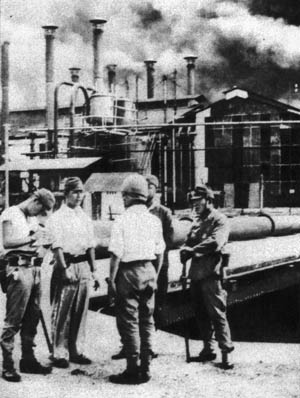
Near noon, a mosquito-bitten Colonel Kume and his handful of staff members finally made their way out of the soggy woodland and over to P1. Undoubtedly, he was happy to see the progress that had been made in his absence. An hour later and right on schedule, the planes of the 2nd Attack Group, the reinforcing paratroop drop, arrived over the Palembang airfield. As the Oscar fighters from the 59th and 64th Sentai flew combat patrol overhead, the Thelmas of the 12th Transport Chutai began dropping the 90 men of Lieutenant Morisawa’s 3rd Rifle Company directly onto the captured airfield. Close behind, the crews of the 98th Sentai began dropping dozens of cargo containers from their Betty bombers.
When the second air drop was over and the precious weapons and ammunition had been distributed, Colonel Kume sent a platoon under Lieutenant Adachi toward Palembang. Moving cautiously, the paratroopers followed the main road past both their own roadblock and the hastily abandoned Dutch roadblock. Arriving at the capital around 5:30 pm, they found the town undefended and parts of Palembang on fire. Moving down to the river to see if the 229th Infantry Regiment barges were in sight, the men happened upon the two Dutch patrol boats, the P-39 and the P-40. They quickly disabled one of the boats, but the other fled upriver.
Upon discovering that Palembang was unguarded, Lieutenant Adachi sent the information back to Colonel Kume, who ordered Lieutenant Morisawa to take his newly dropped 3rd Rifle Company into Palembang to secure the town. By early evening, Lieutenant Morisawa was in contact with the soldiers holding the two oil refineries.
That evening, February 15, protected by darkness, the landing barges carrying the 229th Infantry Regiment finally reached Palembang. Waiting there to greet them were the army paratroopers of the 2nd Raiding Regiment. Five days later, the proud paratroopers handed over control of the capital of Sumatra to the 38th Infantry Division.
After all was settled, the 2nd Raiding Regiment reviewed the past few days. The paratroopers claimed that they had killed 1,080 Dutch and RAF defenders and captured a total of 23 antiaircraft guns, several armored cars, and numerous trucks. Of course, these figures are much exaggerated. On the other hand, the Japanese admitted that during the initial combat drop one medium bomber was shot down either by antiaircraft fire or by Pilot Officer Lockwood while two transport planes were crash landed, one intentionally. Out of 339 paratroopers dropped, 29 were killed (two died due to parachute malfunction), 37 were seriously wounded, and 11 were slightly wounded, a loss of roughly 23 percent.
The 2nd Raiding Regiments’ attack on P1 and the two oil refineries has been deemed both a success and a failure by historians. In October 1942, a brief intelligence document was published by the U.S. Army that labeled the attack a failure. The report stated that the Japanese “jumped from about 70 transport planes,” a gross exaggeration. The report continued, “A total of about 300 attacked defending troops at the airdrome, and about 400 sought to capture the refineries. Nearly all the parachutists were killed or captured, except a group which managed to hold one of the refineries and prevent it from being destroyed. The other refinery was demolished by the Dutch. On the whole, the attack was a failure.” Two other Army reports, one published in 1942 and another in 1945, continued to inflate the number of Japanese attackers and repeat that the attack had failed to achieve its objective of capturing the oil refineries intact.
As time went by, however, historians began to study the attack and correct most of the inaccuracies. In no time at all, Japanese tankers were carrying the vital refined oil back to their home islands.
In spite of their success, the army paratroopers saw no further combat on Sumatra. The 38th Infantry Division, with the help of Japanese bombers and fighters flying out of P1, continued to advance across southern Sumatra and by February 24 had secured much of the island. By the beginning of March, most of the remaining Dutch defenders had fled into the northwestern part of the island and were conducting a guerrilla war. On March 28, 1942, some 2,000 Dutch troops surrendered to the 38th Infantry Division. The island of Sumatra was securely in Japanese hands.
Gene Eric Salecker is a retired university police office who teaches eighth grade social studies in Bensenville, Illinois. He is the author of four books, including Blossoming Silk Against the Rising Sun: US and Japanese Paratroopers in the Pacific in World War II. He resides in River Grove, Illinois.
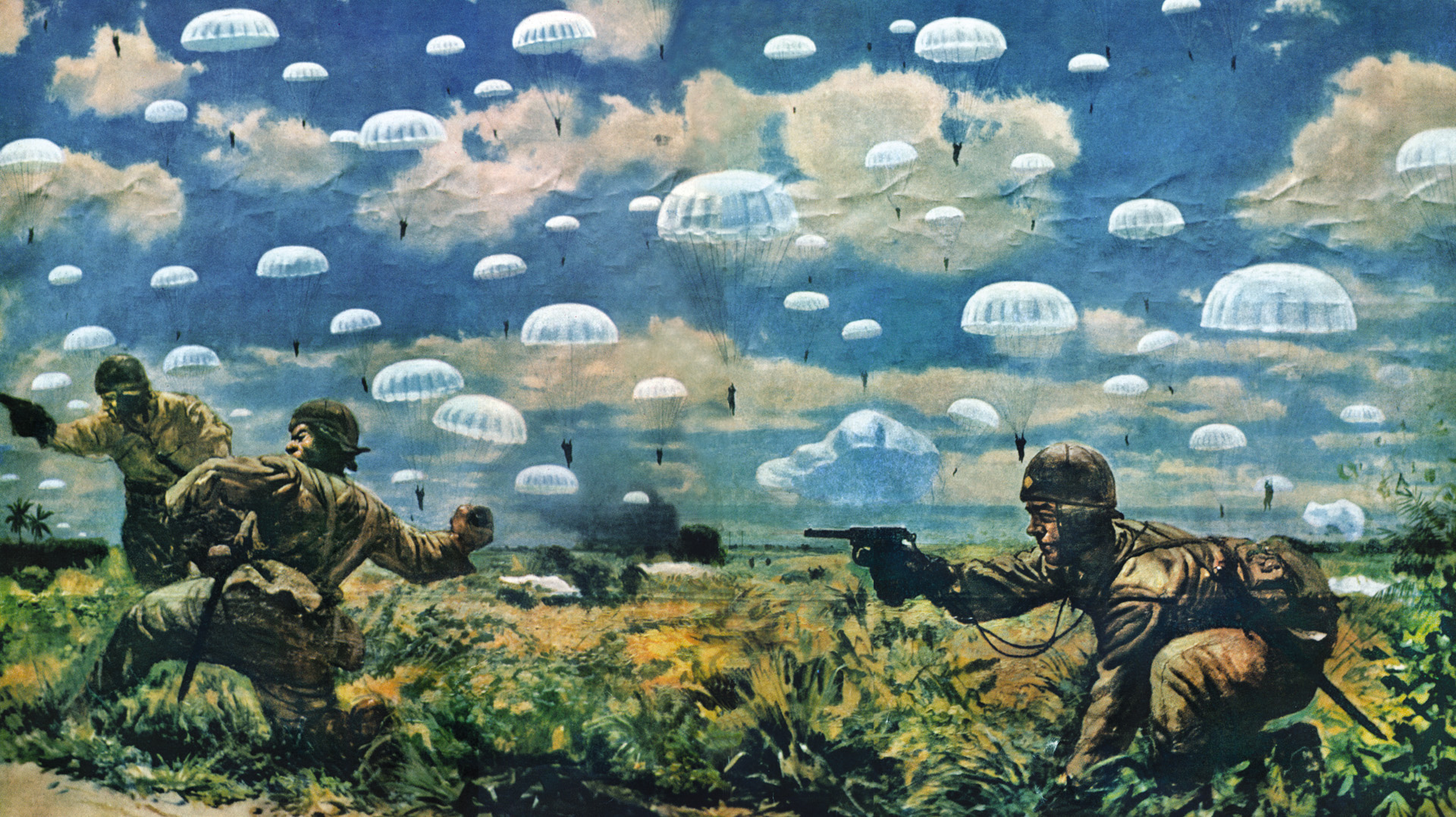
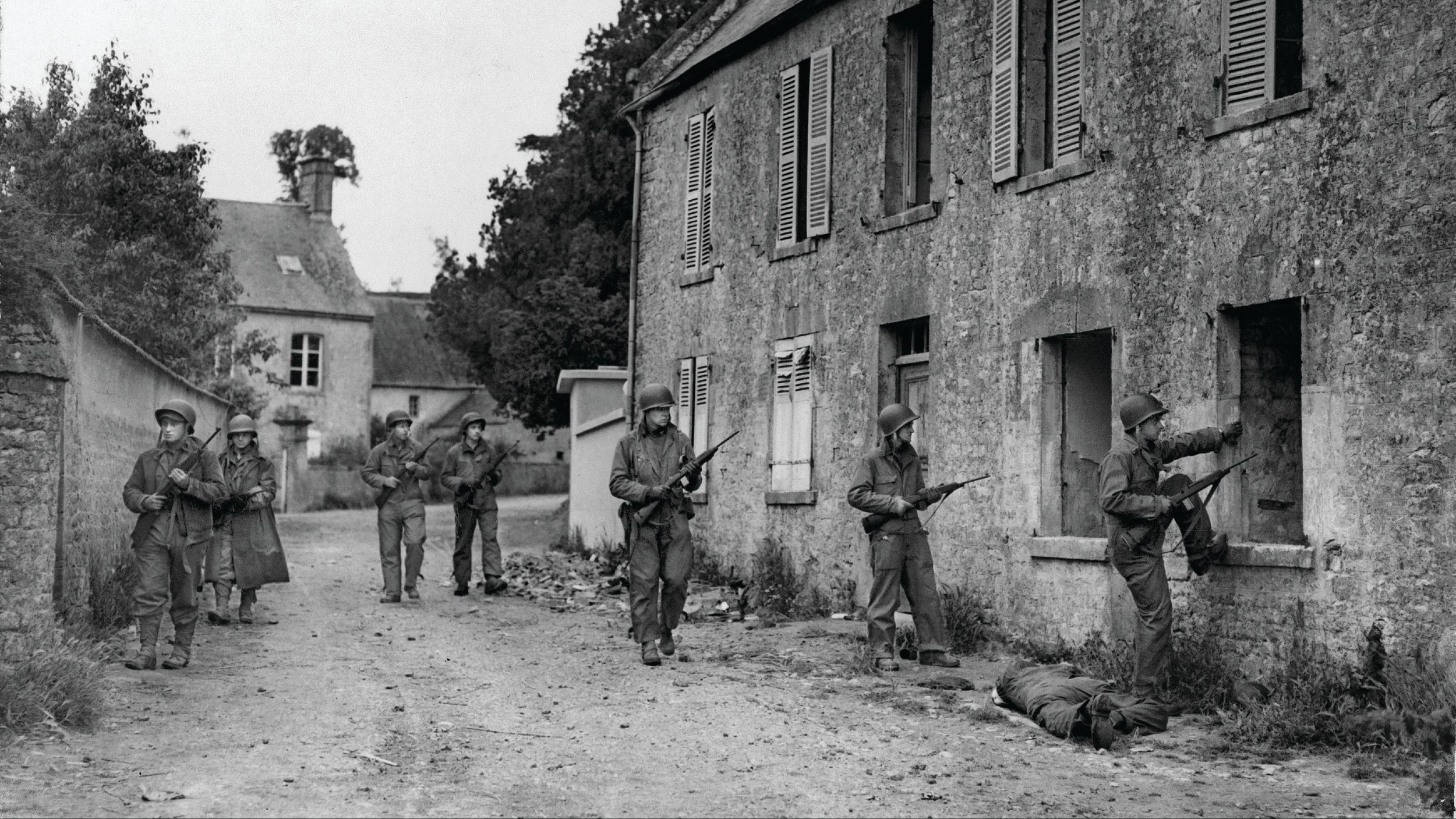
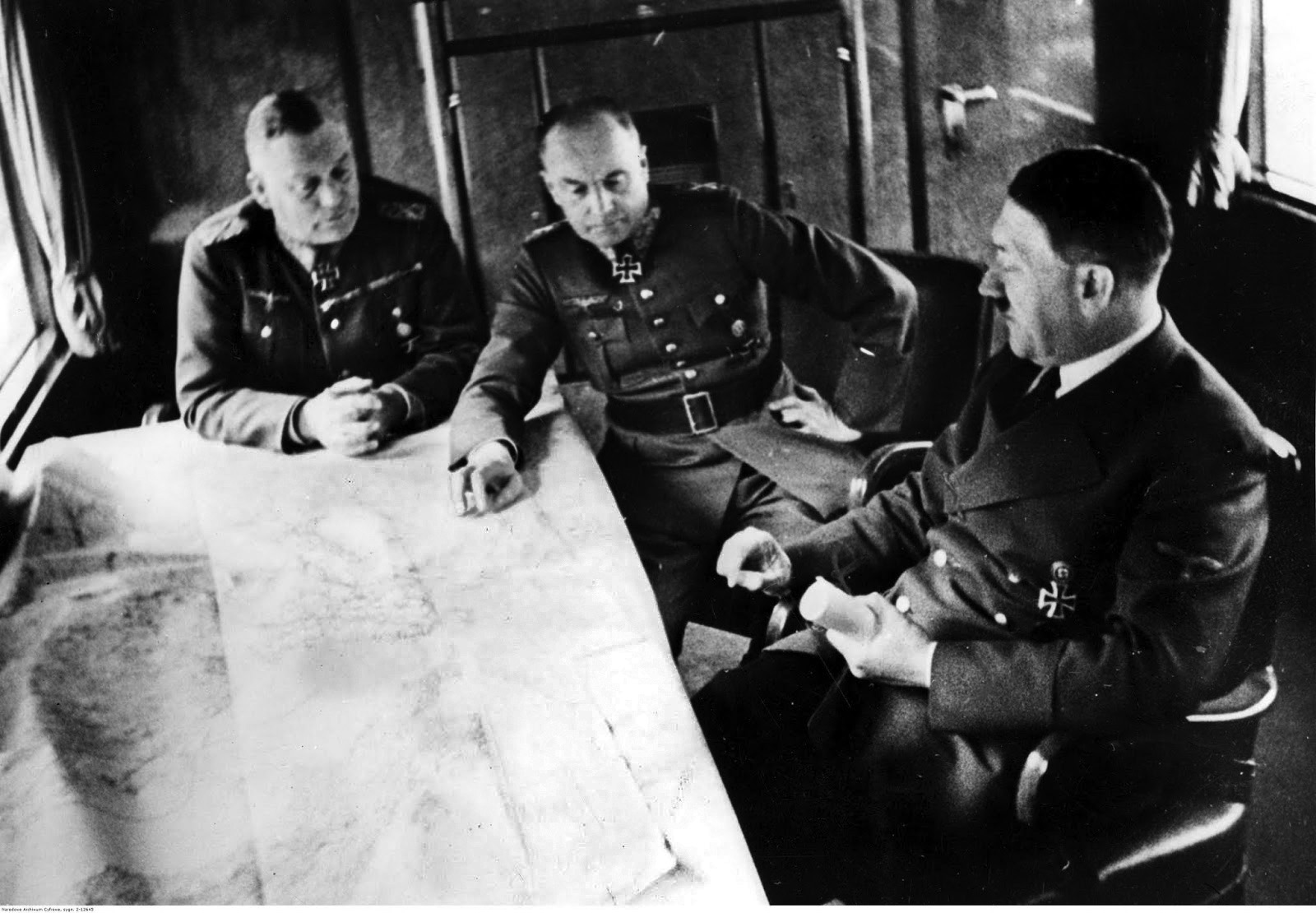
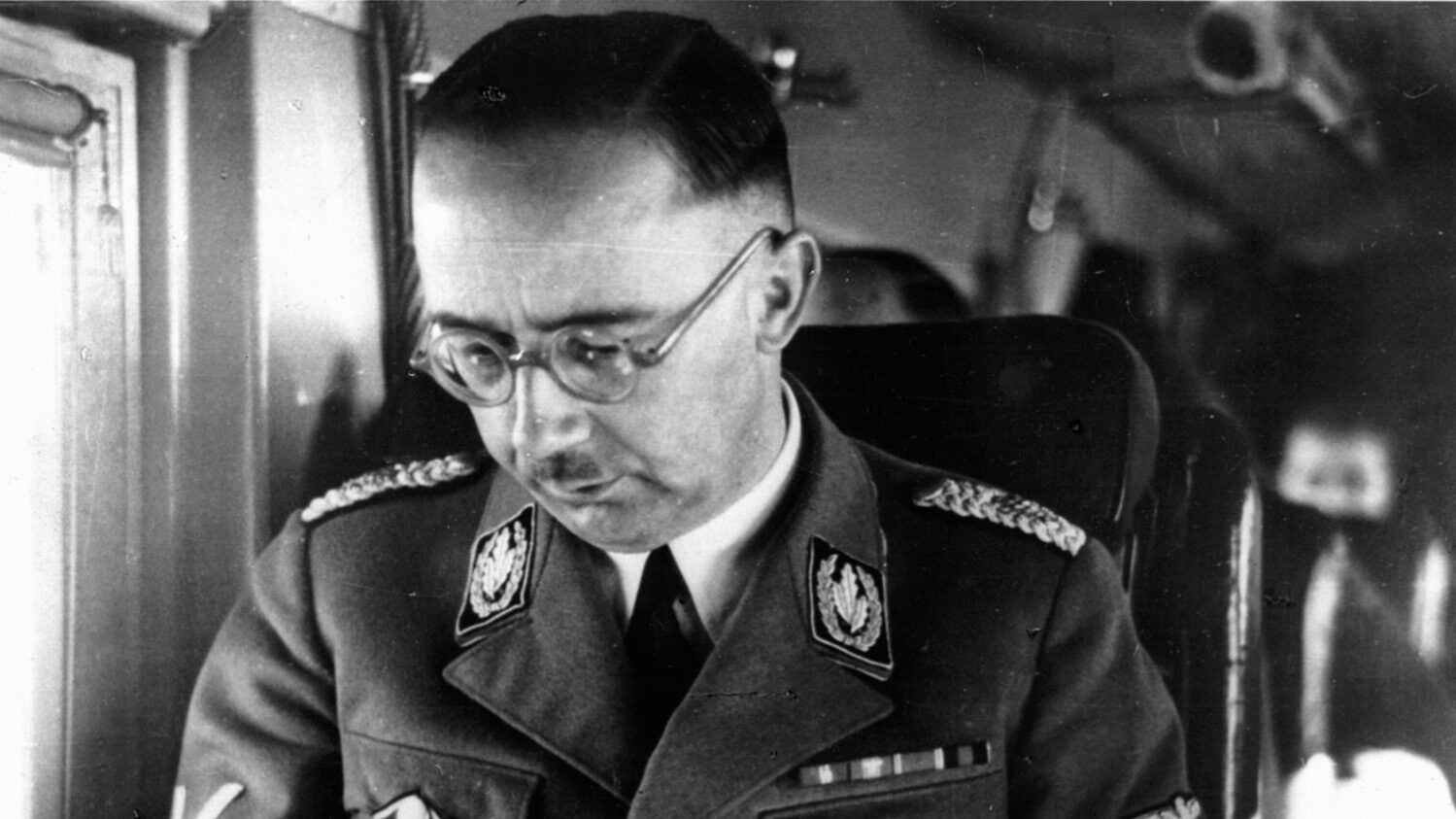
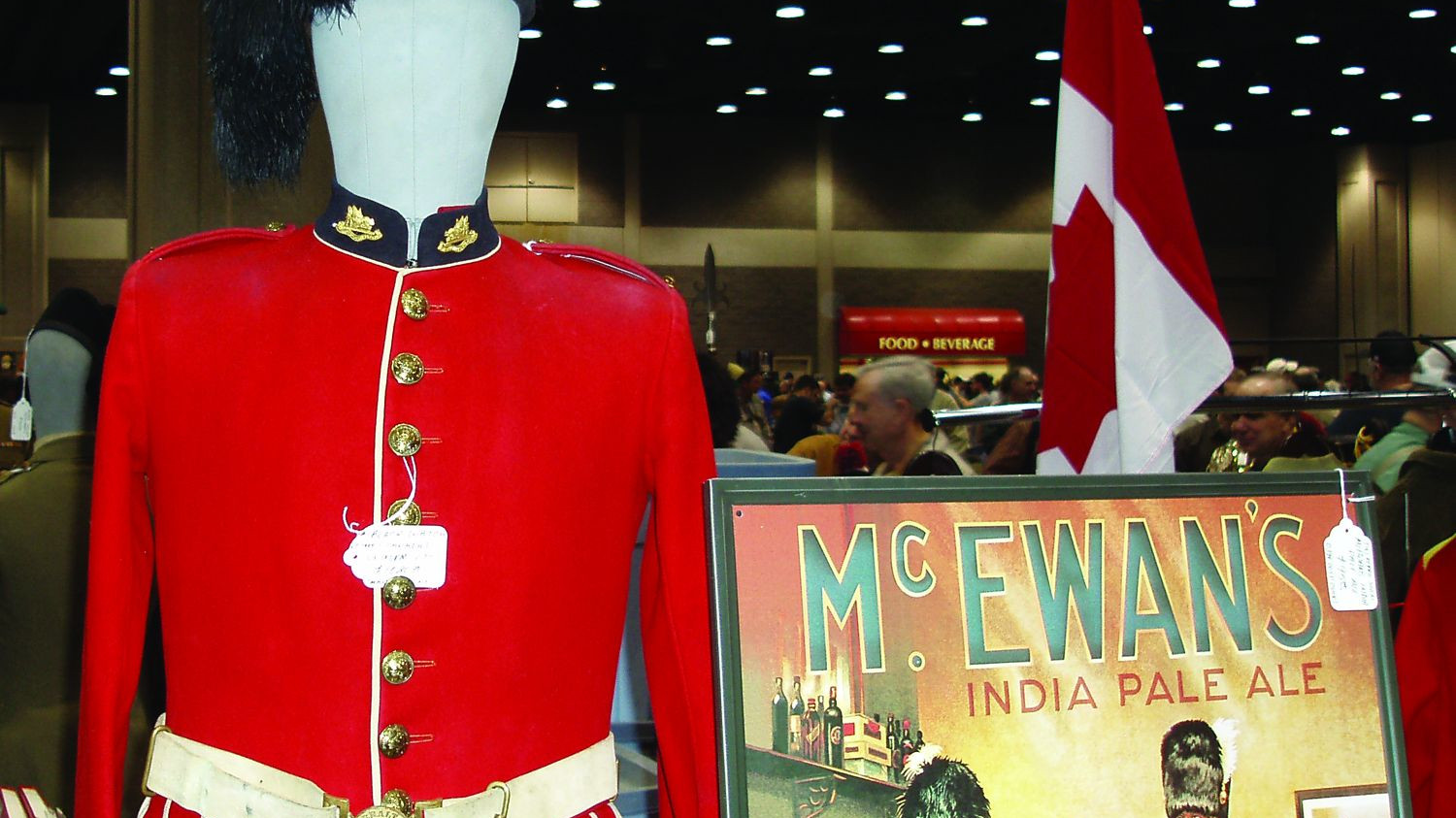
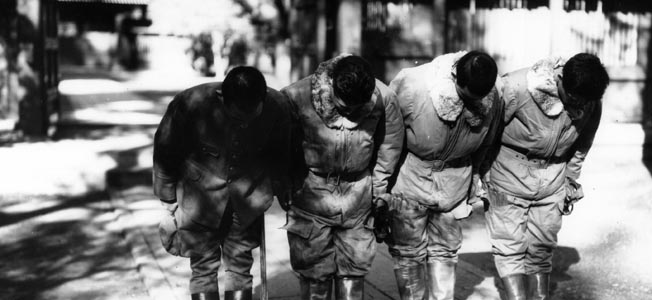
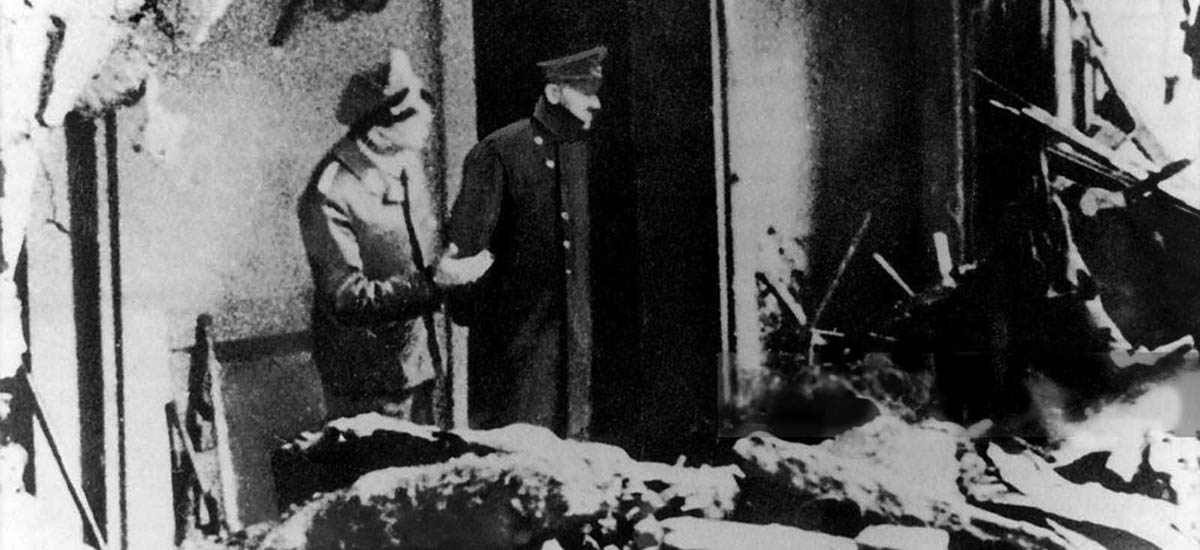
Join The Conversation
Comments
View All Comments